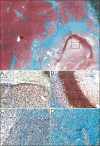Endoscopic ultrasound-guided radiofrequency ablation of the pancreas: An experimental study with pathological correlation
- PMID: 26643702
- PMCID: PMC4672592
- DOI: 10.4103/2303-9027.170426
Endoscopic ultrasound-guided radiofrequency ablation of the pancreas: An experimental study with pathological correlation
Abstract
Background: The treatment of pancreatic cancer represents a major objective in clinical research, as it still remains the fourth leading cause of cancer deaths among men and women, with approximately 6% of all cancer-related deaths.
Materials and methods: We studied the assessment of an endoscopic ultrasound (EUS)-guided radiofrequency ablation (RFA) probe through a 19G needle in order to achieve a desirable necrosis area in the pancreas. Radiofrequency ablation of the head of the pancreas was performed on 10 Yorkshire pigs with a weight between 25 kg and 35 kg and a length of 40-70 cm. Using an EUS-guided RFA experimental probe, we ablated an area of 2-3 cm width. The biological samples were harvested after 3 days and 5 days and necropsy was performed 1 week after the procedure.
Results: All pigs showed no significant change regarding their behavior and no signs of complication was encountered. Blood analysis revealed increased values of amylase, alkaline phosphatase, and gamma-glutamyl transpeptidase on the 3rd day but a decrease on the 5th day. After necropsy and isolation of the pancreas, the ablated area was easily found, describing a solid necrosis. The pathological examination revealed a coagulative necrosis area with minimal invasion and inflammatory tissue at about 2 cm surrounding the lesion.
Conclusion: EUS-RFA is a feasible technique and might represent a promising therapy for the future treatment of pancreatic cancer. However, further studies are necessary to investigate EUS-guided RFA as an option for palliation in pancreatic cancer until it can be successfully used in human patients.
Figures






References
-
- Atlanta: American Cancer Society; 2010. American Cancer Society. Cancer Facts and Figures 2010.
-
- Li D, Xie K, Wolff R, et al. Pancreatic cancer. Lancet. 2004;363:1049–57. - PubMed
LinkOut - more resources
Full Text Sources
Other Literature Sources
